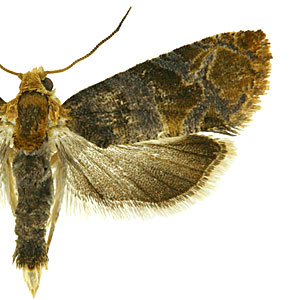Overview

The genus Paralobesia contains 18 described, and numerous undescribed species. All but one are Nearctic; Razowski (2003) placed the Palearctic P. andereggiana in Lobesia but it appears that this species should remain in Paralobesia based on his drawing of the male genitalia. Moths in this genus are difficult to identify because of the various undescribed species and the lack of understanding of described species. Gilligan et al. (2008) detail the taxonomic history of this group and provide descriptions for many of the eastern North American species.
Adults are small (FWL 4.5-8.0 mm) and many species are leaden-gray with reddish brown fasciae. Wing pattern is not diagnostic for many species, and a genitalic dissection is necessary to confirm identity. Male genitalia are characterized by a cluster of long setae on the ventral margin of the sacculus, referred to as the saccular tuft, and a U-shaped indentation of the ventral margin of the valval neck, often with facing padlike projections. Female genitalia are characterized by a cone-shaped sterigma and two accessory sacs on the anterior end of the corpus bursae in some species.
The most familiar member of this genus is the grape berry moth, P. viteana. This species is a pest of grape in eastern North America, and larvae cause direct and indirect damage by feeding on grape berries. Adults can be confused with those of Lobesia botrana, which was discovered in California in 2008-2009. Adults of P. viteana and L. botrana cannot be separated by wing pattern; a genitalic dissection is necessary to confirm identity. The two species are easily separated using male or female genitalia.
While most Paralobesia species appear to be restricted to eastern North America, at least three are present on the West Coast. Paralobesia palliolana and two undescribed species have been recorded from Washington, Oregon, and California; Gilligan et al. (2011) detail these discoveries.
Non-target species
Paralobesia viteana
References

Botero-Garces, N. and R. Isaacs. 2003. Distribution of grape berry moth, Endopiza viteana (Lepidoptera: Tortricidae) in natural and cultivated habitats. Environmental Entomology. 32: 1187-1195.
Gilligan, T. M., D. J. Wright and L. D. Gibson. 2008. Olethreutine moths of the midwestern United States, an identification guide. Ohio Biological Survey, Columbus, Ohio. 334 pp.
Gilligan, T. M., M. E. Epstein, S. C. Passoa, J. A. Powell, O. C. Sage and J. W. Brown. 2011. Discovery of Lobesia botrana ([Denis & Schiffermuller]) in California: an invasive species new to North America (Lepidoptera: Tortricidae). Proceedings of the Entomological Society of Washington. 113(1): 14-30.
Razowski, J. 2003. Tortricidae of Europe, Vol. 2, Olethreutinae. Frantisek Slamka, Slovakia. 301 pp.

